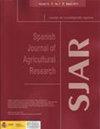土耳其蜜蜂花粉的抗氧化特性、元素含量及抗菌活性
IF 0.8
4区 农林科学
Q3 AGRICULTURE, MULTIDISCIPLINARY
引用次数: 0
摘要
研究目的:近年来,花粉因其复杂的成分而成为人们首选的营养补充剂。研究了蜜蜂花粉的植物来源、总酚/类黄酮含量(TPC/TFC)、抗氧化/抗菌活性和元素含量。这项研究还调查了花粉中所含的元素,当作为食物食用时,是否会对人体健康构成风险。研究领域:从土耳其四个不同地区的蜂房随机采集了10个混合花粉样本,这些地区属于土耳其本文章由计算机程序翻译,如有差异,请以英文原文为准。
Antioxidant properties, element contents and antimicrobial activities of bee pollen collected by Apis mellifera L. in Türkiye
Aim of study: Recently, pollen has become a preferred nutritional supplement because of its complex composition. We examined the botanical origin, total phenolic/flavonoid content (TPC/TFC), antioxidant/antimicrobial activity, and element content of pollen samples collected from honeybees. This study also examined whether the elements contained in pollen, when consumed as food, posed a risk to human health.
Area of study: Ten mixed pollen samples were randomly collected from honeybees in the apiaries of four different Turkish regions, which fall among the three phytogeographic regions of Türkiye.
Material and methods: We evaluated total flavonoid (TFC) and phenolic (TPC) contents; antioxidant activities (radical scavenging activity, hydrogen peroxide scavenging activity - HPSA, ferric reducing antioxidant power - FRAP, and ferrous ion chelating activity - FICA), element concentrations and antimicrobial activity.
Main results: According to the melissopalynological analysis, one sample was determined to be unifloral and nine samples were found to be multifloral. The values found ranged 271.42-601.85 mg GAE/100 g TPC, 23.53-34.50 mg CAE/100 g TFC, 22.19-23.78 μg/mL DPPH, 6.50-78.40 µg/mL ABTS, 20.43-150.94 μg/mL HPSA, 97.26-99.83% FRAP and 74.84-91.79% FICA. P-coumaric acid, rosmanic acid, quercetin, apigenin, and naringin were identified in all samples, while catechin was detected only in S6 and S7. Element contents were found Mg > Fe > Mn > Zn > Cu > Se > Cr > Ni > Cd > Co. All the samples had high antibacterial activity against Bacillus cereus (MIC= 4.17-8.33 g/mL), and against Staphylococcus aureus (MIC= 8.33 g/mL), except S3 and S4.
Research highlights: Different levels and combinations of these components are efficient in the antioxidant and antibacterial activity of pollen.
求助全文
通过发布文献求助,成功后即可免费获取论文全文。
去求助
来源期刊

Spanish Journal of Agricultural Research
农林科学-农业综合
CiteScore
2.00
自引率
0.00%
发文量
60
审稿时长
6 months
期刊介绍:
The Spanish Journal of Agricultural Research (SJAR) is a quarterly international journal that accepts research articles, reviews and short communications of content related to agriculture. Research articles and short communications must report original work not previously published in any language and not under consideration for publication elsewhere.
The main aim of SJAR is to publish papers that report research findings on the following topics: agricultural economics; agricultural engineering; agricultural environment and ecology; animal breeding, genetics and reproduction; animal health and welfare; animal production; plant breeding, genetics and genetic resources; plant physiology; plant production (field and horticultural crops); plant protection; soil science; and water management.
 求助内容:
求助内容: 应助结果提醒方式:
应助结果提醒方式:


